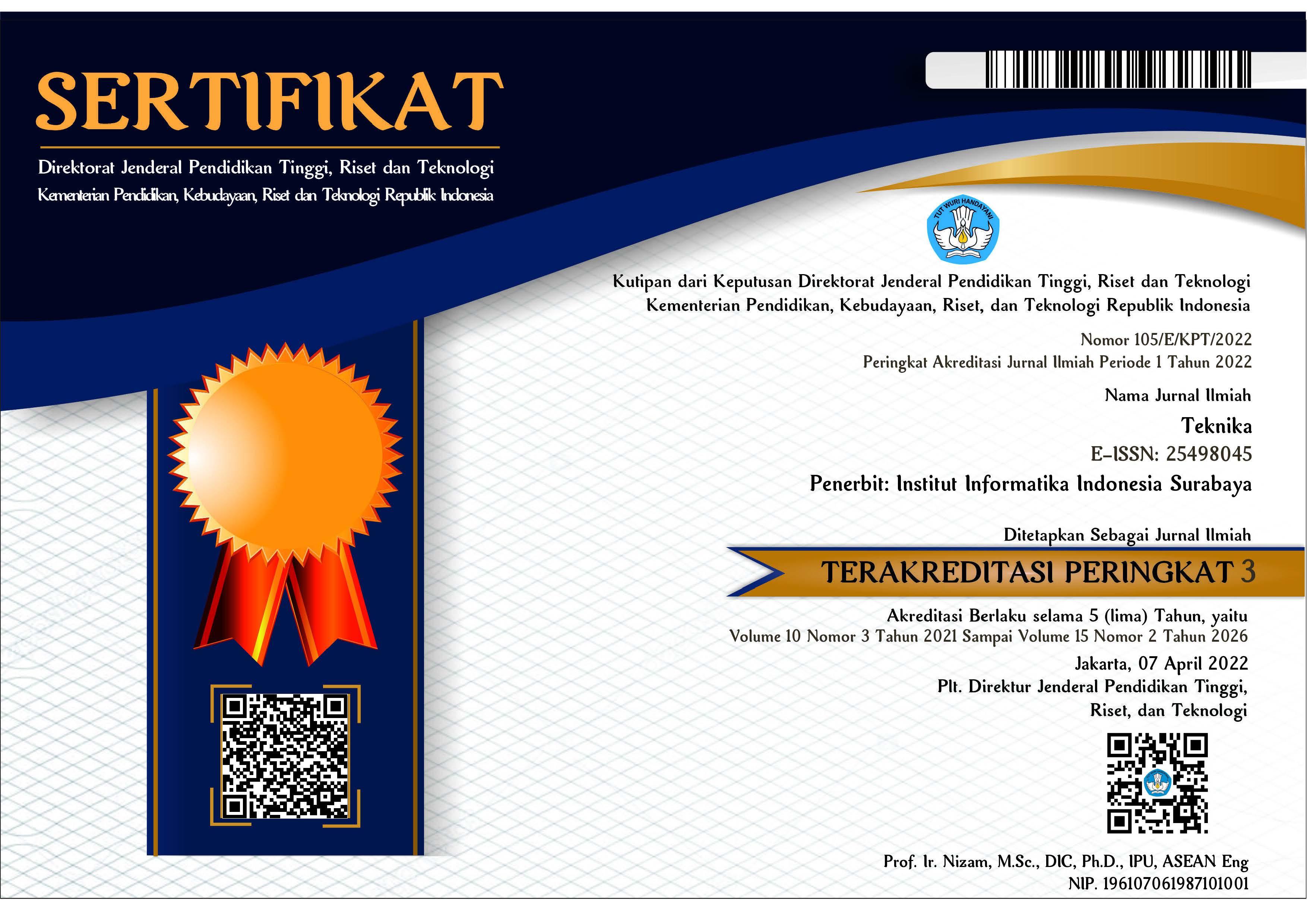Estimasi Arah Tatapan Mata Menggunakan Ensemble Convolutional Neural Network
Abstract
Studi arah tatapan mata adalah salah satu masalah dalam bidang computer vision. Pengetahuan akan arah tatapan mata dapat memberikan informasi berharga yang dapat dimanfaatkan untuk berbagai macam keperluan dalam bidang lainnya, khususnya dalam bidang interaksi manusia dengan komputer. Dalam paper ini nantinya akan meneliti arah tatapan mata menggunakan Ensemble Convolutional Neural Network dengan menggunakan dataset CAVE (Columbia Gaze Dataset). Convolutional Neural Netwok (CNN) merupakan sebuah bidang keilmuan dalam bidang machine learning yang berkembang cukup pesat khususnya untuk mengklasifikasi citra. Nantinya, paper ini akan menganalisa dan membandingkan hasil F1 score dan weighted kappa (w-kappa) score serta error dari klasifikasi dengan menggunakan 3, 9, dan 21 kelas. Dengan sama-sama menggunakan kanal RGB sebagai gambar input, maka dapat dibandingkan dan disimpulkan bahwa dengan menggunakan metode Ensemble Convolutional Neural Network dengan koefisien 1 untuk mata kiri, 1 untuk mata kanan, dan 3 untuk kedua mata untuk klasifikasi dengan 3 dan 9 kelas, serta dengan koefisien 1 untuk mata kiri, 1 untuk mata kanan, dan 5 untuk kedua mata untuk klasifikasi dengan 21 kelas dapat menghasilkan hasil F1 score dan w-kappa yang lebih baik, serta tingkat error yang lebih rendah daripada menggunakan koefisien dengan nilai lainnya.
Downloads
References
Coates, A., Arbor, A., & Ng, A.Y. (2011). An Analysis of Single-Layer Networks in Unsupervised Feature Learning. Aistats 2011, 15, pp. 215—223. https://doi.org/10.1109/ICDAR.2011.95
Florea, L., & Vertan, C. (2013). Can Your Eyes Tell Me How You Think? A Gaze Directed Estimation of the Mental Activity. Bmvc2013, pp. 1—11. https://doi.org/10.5244/C.27.60
Fukushima, K. (1980). Neocognitron: A Self-organizing Neural Network Model for a Mechanism of Pattern Recognition Unaffected by Shift in Position. Biological Cybernetics, 36(4), pp. 193—202. https://doi.org/10.1007/BF00344251
George, A., & Routray, A. (2016). Real-time Eye Gaze Direction Classification Using Convolutional Neural Network.
Kazemi, V., & Sullivan, J. (2014). One Millisecond Face Alignment with an Ensemble of Regression Trees. Proceedings of the IEEE Computer Society Conference on Computer Vision and Pattern Recognition, pp. 1867—1874. https://doi.org/10.1109/CVPR.2014.241
Kingma, D.P., & Ba, J. (2014). Adam: A Method for Stochastic Optimization, pp. 1—15. https://doi.org/10.1145/1830483.1830503
Krafka, K., Khosla, A., & Kellnhofer, P. (n.d.). Eye Tracking for Everyone.
Kristian, Y., Takahashi, H., Purnama, I.K.E., Yoshimoto, K., Setiawan, E.I., Hanindito, E., & Purnomo, M.H. (2017). A Novel Approach on Infant Facial Pain Classification Using Multi Stage Classifier and Geometrical-textural Features Combination. IAENG International Journal of Computer Science, 44(1), pp. 112—121.
Meyer, A., Böhme, M., Martinetz, T., & Barth, E. (2006). A Single-Camera Remote Eye Tracker (pp. 208—211). Berlin: Springer, Heidelberg. https://doi.org/10.1007/11768029_25
Morimoto, C.H., Amir, A., & Flickner, M. (n.d.). Detecting Eye Position and Gaze from a Single Camera and 2 Light Sources. In Object Recognition Supported by User Interaction for Service Robots. IEEE Comput. Soc., Vol. 4, pp. 314—317. https://doi.org/10.1109/ICPR.2002.1047459
Setyati, E., Kristian, Y., Pranoto, Y.M., & Alexandre, D. (2013). Augmented Reality 3D Eyeglasses Frame Simulator Using Active Shape Model and Real Time Face Tracking. 2013 Eleventh International Conference on ICT and Knowledge Engineering, pp. 1—5. https://doi.org/10.1109/ICTKE.2013.6756272
Sheela, S.V, Vijaya, P.A., & College, B.M.S. (2011). An Appearance Based Method for Eye Gaze Tracking, 7(8), pp. 1194—1203.
Shih, S.W., & Liu, J. (2004). A Novel Approach to 3-D Gaze Tracking Using Stereo Cameras. IEEE Transactions on Systems, Man and Cybernetics, Part B (Cybernetics), 34(1), pp. 234—245. https://doi.org/10.1109/TSMCB.2003.811128
Smith, B.A., Yin, Q., Feiner, S.K., & Nayar, S. K. (2013). Gaze Locking: Passive Eye Contact Detection for Human-Object Interaction. ACM Symposium on User Interface Software and Technology, pp. 271—280. https://doi.org/10.1145/2501988.2501994
Stephenson, G.M., & Rutter, D.R. (1970). Eye-Contact, Distance and Affiliation. British Journal of Psychology, 61(3), 385—393. https://doi.org/10.1111/j.2044-8295.1970.tb01257.x
Valenti, R., & Gevers, T. (2008). Accurate Eye Center Location and Tracking Using Isophote Curvature. 26th IEEE Conference on Computer Vision and Pattern Recognition, CVPR. https://doi.org/10.1109/CVPR.2008.4587529
Valstar, M., Martinez, B., Binefa, X., & Pantic, M. (2010). Facial Point Detection Using Boosted Regression and Graph Models. Proceedings of the IEEE Computer Society Conference on Computer Vision and Pattern Recognition, pp. 2729—2736. https://doi.org/10.1109/CVPR.2010.5539996
Villanueva, A., Cabeza, R., & Porta, S. (2006). Eye Tracking: Pupil Orientation Geometrical Modeling. Image and Vision Computing, 24(7), pp. 663—679. https://doi.org/10.1016/j.imavis.2005.06.001
Villanueva, A., Cabeza, R., & Porta, S. (2007). Gaze Tracking System Model Based On Physical Parameters. International Journal of Pattern Recognition and Artificial Intelligence, 21(05), pp. 855—877. https://doi.org/10.1142/S0218001407005697
Vrânceanu, R., Florea, C., Florea, L., & Vertan, C. (2013). NLP EAC recognition by component separation in the eye region. Lecture Notes in Computer Science
(Including Subseries Lecture Notes in Artificial Intelligence and Lecture Notes in Bioinformatics), 8048 LNCS(PART 2), pp. 225—232. https://doi.org/10.1007/978-3-642-40246-3_28
LeCun, Y. (1990). Handwritten Digit Recognition with a Back-Propagation Network.
Zhang, X., Yusuke, Y., Fritz, M., & Bulling, A. (2015). Appearance-Based Gaze Estimation in the Wild, 1—10.
Zhu, X., & Ramanan, D. (2012). Face Detection, Pose Estimation, and Landmark Localization in the Wild. Proceedings of the IEEE Computer Society Conference on Computer Vision and Pattern Recognition, pp. 2879—2886. https://doi.org/10.1109/CVPR.2012.6248014

Copyright (c) 2018 Teknika

This work is licensed under a Creative Commons Attribution-ShareAlike 4.0 International License.






















